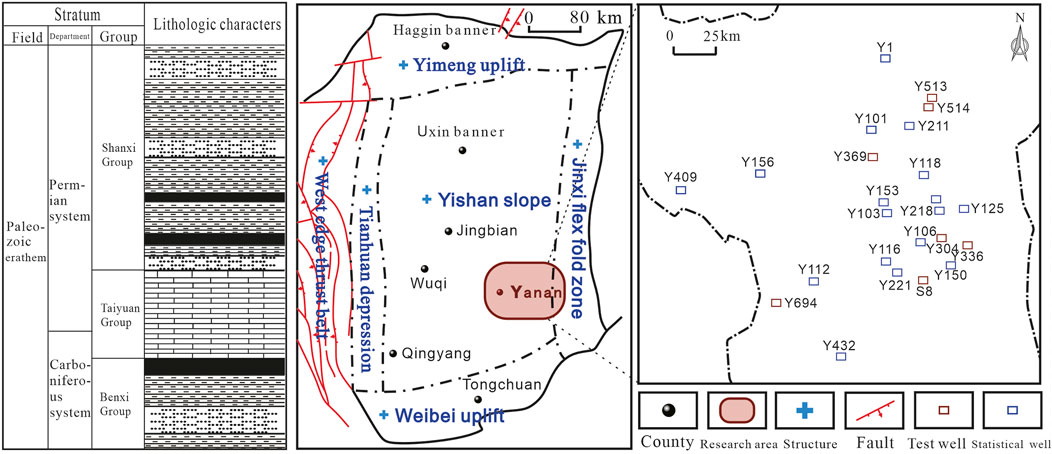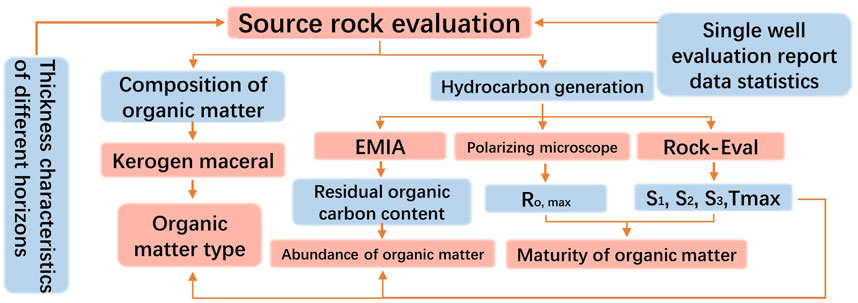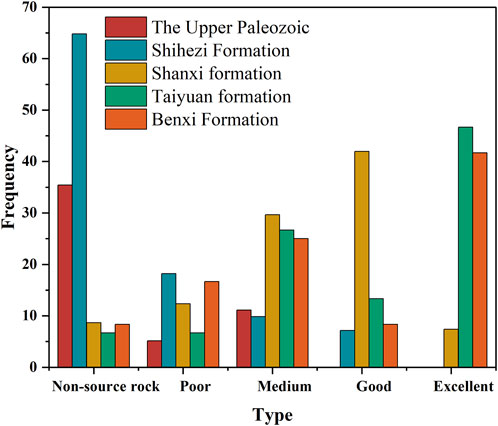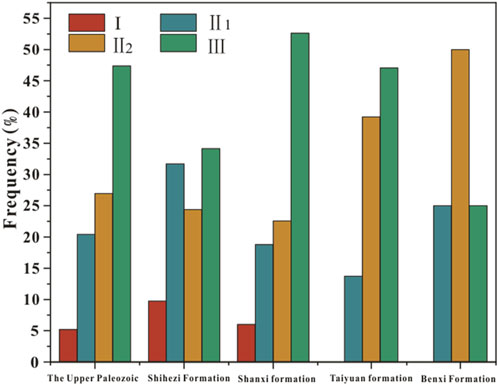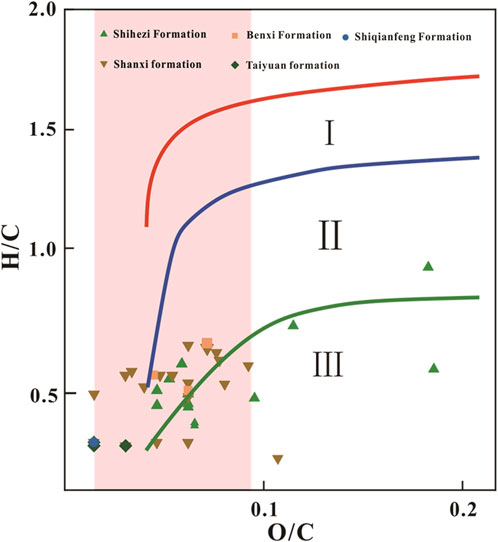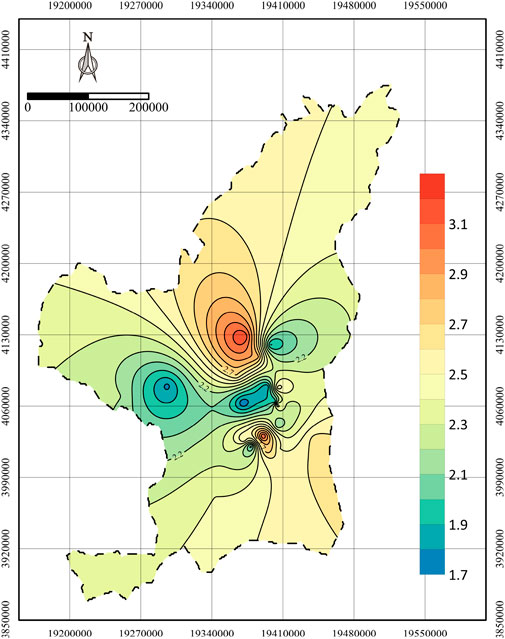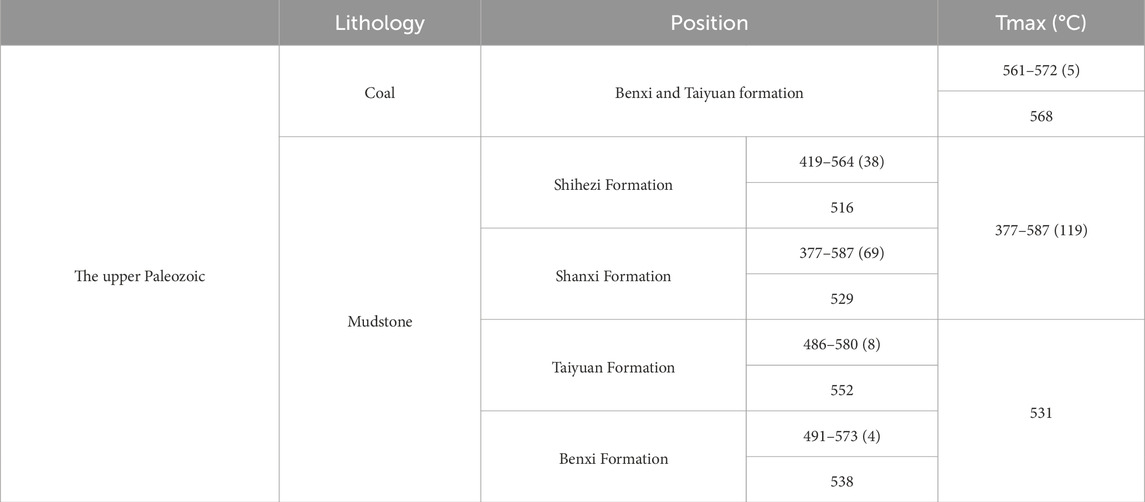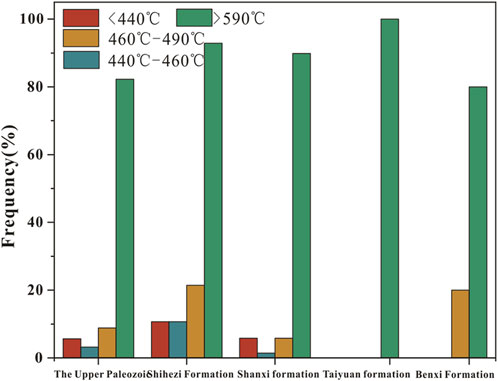- 1Gas Field Company, Shaanxi Yanchang Petroleum (Group) Co., Ltd., Xi’an, China
- 2Key Laboratory of Coalbed Methane Resources and Reservoir Formation Process, Ministry of Education, Xuzhou, China
- 3School of Resources and Geosciences, China University of Mining and Technology, Xuzhou, China
- 4Energy Research Institute, Peking University, Beijing, China
Introduction: The Yanchang gas field in the southeastern Ordos Basin is an important region for natural gas exploration due to the presence of Upper Paleozoic coal-bearing source rocks. This study systematically evaluates these source rocks in terms of organic matter abundance, type, and thermal maturity to assess their hydrocarbon generation potential.
Methods: Organic geochemical analyses were performed to determine the total organic carbon (TOC) content, kerogen type, and thermal maturity of the source rocks. The Benxi and Taiyuan Formations were specifically targeted for detailed evaluation. Kerogen maceral analysis was used to classify organic matter types, while thermal maturity was assessed through vitrinite reflectance (Ro) values.
Results: The results indicate that the Upper Paleozoic source rocks exhibit high TOC content, with the Benxi and Taiyuan Formations showing excellent hydrocarbon generation potential. Kerogen maceral analysis identified predominantly Type III (humic) kerogen with some Type II2 (humic-sapropelic) components, suggesting a strong capacity for gas generation. Thermal maturity analysis revealed that the source rocks have reached the overmature dry gas stage, signifying advanced thermal evolution.
Discussion: The findings highlight the central and southern parts of the Yanchang gas field as promising exploration targets, characterized by high TOC content, favorable kerogen type indices, and high Ro values. These features collectively demonstrate the significant hydrocarbon generation potential of the Upper Paleozoic source rocks.
Conclusion: The Upper Paleozoic coal-bearing source rocks in the Yanchang gas field represent a highly prospective target for natural gas exploration, particularly in regions with favorable organic geochemical properties.
1 Introduction
The global energy demand is projected to grow by approximately 3.3% in 2024, with fossil fuels continuing to dominate the energy structure, accounting for 75% of the total energy supply (International Energy Agency, IEA) (IEA, 2023; Karakurt and Aydin, 2023; Ozdemir, 2023). As demand for energy increases, the exploration and development of hydrocarbons such as oil and natural gas remain crucial for economic stability and growth. However, the development of new hydrocarbon resources requires an enhanced understanding of subsurface formations, particularly source rocks, which play an essential role in oil and gas generation.
Traditionally, laboratory measurements, paleontological data, and well logs have been used to perform mineralogical and chemical analyses for the classification of rock samples. Despite their value, these methods are time-consuming and can have limited accuracy, especially in complex geological environments. To address these limitations, recent advancements in digital intelligence technologies have been applied to geological research, particularly in the exploration and classification of hydrocarbon-bearing formations. By integrating clustering, classification, data mining, and statistical methods, these new approaches offer improved accuracy in classification predictions and accelerate the entire process (Ashraf et al., 2024a). This technological shift presents a significant opportunity to enhance the evaluation of lithofacies and source rock characterization.
The accurate identification of organic geochemical characteristics in source rocks is fundamental to natural gas exploration and development. Source rock evaluation plays a critical role in determining the hydrocarbon generation potential of a basin, providing vital insights into oil and gas resource potential and guiding exploration and development activities. However, predicting extractable lithofacies in complex and heterogeneous geological environments remains a challenge. Recent research has demonstrated the value of digital intelligence strategies, which employ multiple classifiers to achieve high-precision lithofacies predictions that are both cost-effective and time-saving. Such advancements are crucial for characterizing hydrocarbon reservoirs, assessing reservoir potential, and optimizing extraction processes (Ashraf et al., 2024b; Tissot and Welte, 1984).
The Ordos Basin is one of China’s most important oil and gas resource bases, significantly contributing to national energy security and economic development (Bai et al., 2020). The main source rocks in this basin are Carboniferous-Permian coal-bearing formations and coal-measure mudstones, which are rich in organic matter, primarily of sapropelic origin. These formations exhibit high organic carbon content and hydrocarbon generation potential, making them key targets for exploration (Chen et al., 2022; Jiang et al., 2023; Kai et al., 2016; Li et al., 2018). Previous studies have investigated the tectonic evolution and stress fields in the eastern part of the Ordos Basin, providing a foundation for understanding the region’s geological characteristics (Wan et al., 2017). These formations are rich in organic matter, primarily of sapropelic origin, and possess high organic carbon content and hydrocarbon generation potential (Li et al., 2023; Liu et al., 2020; Lu et al., 2018; Ma et al., 2020; Wu and Zhang, 2018; Zhao et al., 2014). Currently, numerous scholars have conducted reverse studies on the tectonic evolution and stress field in the eastern part of the Ordos Basin, achieving substantial research results (Wan et al., 2017). Understanding the physical and mechanical properties of reservoir rocks, including the influence of acidification on porosity and permeability, is also critical for improving extraction efficiency and assessing reservoir potential (Dai et al., 2007; Lü et al., 2024; Runsheng et al., 2023; Hu et al., 2024; Umar et al., 2020).
The aim of this study is to systematically evaluate the source rocks of the Upper Paleozoic in the Ordos Basin, thoroughly determine their characteristics, and identify favorable areas for hydrocarbon exploration. By analyzing the organic geochemical characteristics of numerous source rock samples collected from multiple wells, a comprehensive assessment of the hydrocarbon generation potential of the Upper Paleozoic strata has been conducted. The findings contribute to the understanding of the geological conditions in the basin, offering valuable insights for the further exploration and development of natural gas resources.
2 Overview of the study area
The Ordos Basin is located on the North China Plate, bordered to the west by the Alxa Block, to the north by the Yinshan, Daqing, and Langshan Mountains, to the south by the Qinling Mountains, stretching from the Liupan and Helan Mountains in the west to the Taihang and Lüliang Mountains in the east. The basin spans across five provinces (autonomous regions): Shanxi, Shaanxi, Ningxia, Gansu, and Inner Mongolia, covering a total area of approximately 370,000 square kilometers (Ashraf et al., 2024a; Ashraf et al., 2024b; Dai et al., 2007). The basin has undergone multiple episodes of intracontinental orogeny and basin formation, dating from the Late Carboniferous to the Middle Triassic. Studies have identified three major sets of hydrocarbon source rocks in the Ordos Basin (Lü et al., 2024; Runsheng et al., 2023; Hu et al., 2024; Umar et al., 2020).
The Yanchang gas region, located in the central-eastern part of the Ordos Basin, is a region with low exploration activity but significant potential. The Upper Paleozoic in this area is predominantly characterized by shore-shallow lacustrine deposits, which provide favorable conditions for the formation and preservation of source rocks. According to existing research, the gas reservoirs in the Upper Paleozoic of the Yanan Gas Field are primarily sourced from coal seams and carbonaceous mudstones of the Upper Paleozoic.
3 Geology of the study area
The Benxi Formation belongs to the Upper Carboniferous and is primarily composed of bluish-gray to black mudstone and sandy mudstone, with a few layers of gray fine sandstone and relatively thick coal seams. It is in disconformable contact with the underlying Majia Formation, with a clear lithological change. The Taiyuan Formation is mainly composed of gray-black limestone and argillaceous limestone, interbedded with thin layers of black mudstone, and is conformably in contact with the Benxi Formation, showing a significant lithological contrast. The Shanxi Formation consists mainly of gray-black mudstone and sandy mudstone, interbedded with coal seams, marking a transition from marine to terrestrial deposition. The Shihezi Formation is composed of gray mudstone and sandstone and is divided into upper and lower parts, with the “Camel Neck Sandstone” at the bottom of the He 8 section, characterized by an erosional surface. The Shiqianfeng Formation is dominated by purple-red mudstone in the upper part, interbedded with thin to thick layers of sandstone; the lower part consists of brownish-red and greenish-gray sandstone, interbedded with thin layers of mudstone. The bottom is medium sandstone containing gravel, conformably in contact with the Shihezi Formation.
Stratigraphic studies indicate that the thicknesses of the Shanxi Formation through to the Shiqianfeng Formation are relatively uniform, while the Benxi and Taiyuan Formations show significant variations in thickness. Notably, the thickness fluctuations of the Benxi Formation are the most pronounced, which is related to the direction of marine transgression. In the region, the strata in the eastern part are thicker, while those in the western part are thinner. Overall, the Benxi Formation in the western part of the study area gradually thins out until it disappears (Figure 1) and (Table 1).
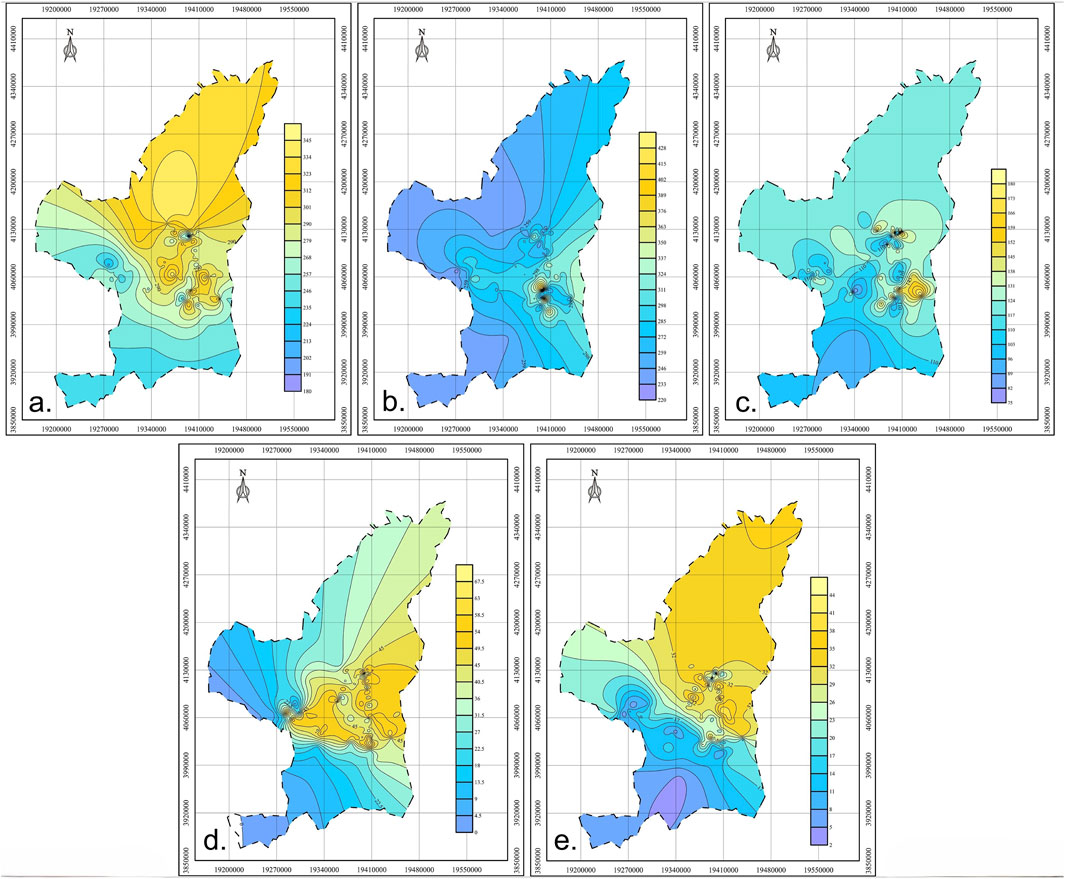
Figure 1. Contour map of Upper Paleozoic thickness in Yanchang gas area. (A) Shiqianfeng Formation; (B) Shihezi Formation; (C) Shanxi Formation; (D) Benxi Formation; (E) Taiyuan Formation.
4 Research method
4.1 Data collection and sample collection
The source rock evaluation data of the Yanan Gas Field in the Ordos Basin were obtained through the collection of existing single-well data and experimental analysis. Data from 17 single wells were gathered, including organic carbon content, chloroform bitumen, hydrocarbon generation potential, microscopic composition characteristics, and vitrinite reflectance. Additionally, for 36 coal-measure source rock samples from 7 new wells, tests were conducted on organic carbon content, vitrinite reflectance, microscopic component observations, and rock pyrolysis analysis. These samples were all core samples, making the test results highly valuable for reference. This approach provides a comprehensive understanding of the variations in organic matter content, thermal maturity, and hydrocarbon generation potential. The distribution of well locations is shown in Figure 2.
4.2 Experimental method
4.2.1 Pyrolysis experiment of rock
According to the GB/T 18602–2012 standard for “Rock Pyrolysis Analysis,” rock pyrolysis experiments were conducted using the ROCK EVAL 6 pyrolyzer to calculate total organic carbon content (TOC), hydrogen index (HI), oxygen index (OI), and hydrocarbon generation potential (He et al., 2016; Li et al., 2019a; Qin et al., 2018; Cui et al., 2023). The source rock samples were dried and crushed to an appropriate particle size to ensure uniformity. The pretreated samples were placed in the pyrolyzer, where the temperature was gradually increased to release organic matter. During the pyrolysis process, the TOC, HI, and OI of the samples were determined. Additionally, the hydrocarbon generation potential (S1 + S2) was calculated, where S1 represents the hydrocarbons that have been generated but not yet expelled from the sample, and S2 represents the potential hydrocarbons that can still be generated.
4.2.2 Organic carbon content testing experiment
Following the GB/T 19145–2022 standard for “Determination of Total Organic Carbon in Sedimentary Rocks,” total organic carbon content in the source rock samples was measured using a carbon-sulfur analyzer (CS744). The pretreated samples were placed in the analyzer, where high-temperature combustion decomposed the organic carbon in the samples, simultaneously measuring the amount of CO₂ released (Xu et al., 2023).
4.2.3 Microscopic component identification and vitrinite reflectance experiment
Based on the SY/T 5125–2014 standard for “Identification and Classification Methods of Microscopic Components in Transmitted Light-Fluorescence Kerogen,” the microscopic component characteristics and vitrinite reflectance (Huo et al., 2019; Li et al., 2019b; Yang et al., 2020) of the source rock thin sections were observed using a polarized light microscope. The samples were examined to identify the microscopic components of kerogen (such as amorphous matter, alginite, and lignin) and to record their relative abundances. Vitrinite reflectance (Ro) was measured using a reflected light microscope to assess the thermal maturity level of the source rocks. The research technology roadmap is shown in Figure 3.
5 Results
5.1 Abundance characteristics of organic matter
5.1.1 Organic carbon content characteristics
The organic carbon content evaluation criteria adopted in this study are derived from the previous classification of organic carbon content of Upper Paleozoic mudstone source rocks in the central Ordos Basin, focusing on the organic carbon content of carboniferous and Permian coal-bearing strata (Ratnayake, 2024; Li, 2015; Chen et al., 2023).
The coal samples primarily originate from the Benxi Formation and the Taiyuan Formation, with total organic carbon (TOC) ranging from 60.34% to 85.15%, and an average value of 68.31%. The carbonaceous mudstones are distributed across the Shanxi, Benxi, and Taiyuan formations, with TOC ranging from 9.12% to 36.8% and an average of 18.79%. In the study area, the organic carbon content of 122 mudstone samples from the Upper Paleozoic varies between 0.04% and 8.41%, with an average of 1.87%, indicating a good hydrocarbon generation capacity (Figure 4).
Analysis of the organic carbon content of source rocks in the Upper Paleozoic of the Ordos Basin shows that the organic carbon indices of mudstones from the Carboniferous-Permian are generally above the moderate hydrocarbon source rock threshold of 0.6%, reaching the standards for moderate source rocks. Additionally, approximately half of the samples meet the criteria for good source rocks, reflecting a favorable hydrocarbon generation potential. Among them, the organic matter content in the mudstone source rocks of the Shihezi Formation ranges from 0.04% to 1.54%, with an average of 0.31%, indicating that most are non-source rocks. The organic carbon content in the mudstone source rocks of the Shanxi Formation ranges from 0.10% to 8.41%, with an average of 1.64%, categorizing them as poor to good source rocks. The organic carbon content in the mudstone source rocks of the Taiyuan Formation varies from 0.36% to 8.21%, averaging 3.45%, placing them in the good to very good source rock category. Finally, the organic carbon content of the mudstone source rocks in the Benxi Formation ranges from 0.16% to 8.13%, with an average of 3.18%, also categorizing them as good to very good source rocks (Table 2).
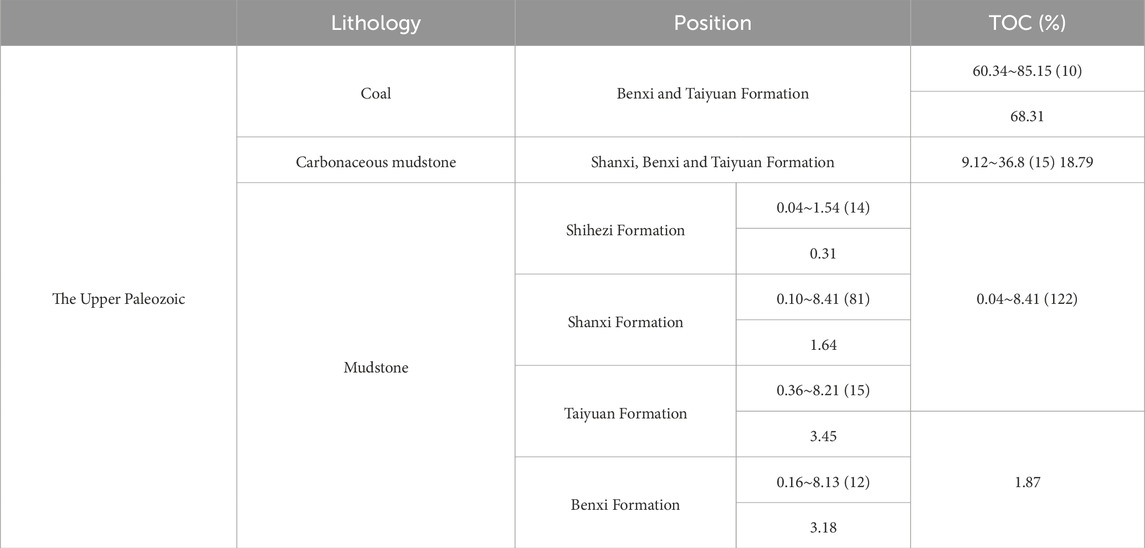
Table 2. Statistical table of organic carbon content of Upper Paleozoic coal measure source rocks in Yan’ an Gas field.
Based on the analysis of organic carbon content in the Upper Paleozoic source rocks of the Yanan Gas Field, it is evident that the organic carbon indices of the Carboniferous to Permian strata generally exceed the moderate hydrocarbon source rock threshold of 0.6%, consistently meeting the criteria for moderate source rocks. Specifically, most samples from the Shihezi Formation are classified as non-source rocks, while the mudstone source rocks from the Taiyuan and Benxi Formations exhibit exceptionally high organic carbon content, reaching the levels of very good source rocks, indicating that this stratigraphic sequence possesses excellent hydrocarbon generation potential. Additionally, the presence of numerous coal seams and carbonaceous mudstones within the study area further highlights their hydrocarbon generation capabilities (Figure 4).
Furthermore, according to the contour map of organic carbon content in the mudstones of the Upper Paleozoic in the Yanan Gas Field (Figure 5), the organic carbon values in the study area display a general trend of lower values in the south and higher values in the north. Only in the Ganquan-Fuxian region does the organic carbon content fall below 0.5%, while most areas exceed the threshold of 1.0% for good source rocks. In the central and northern regions of the study area, organic carbon content typically reaches above 3.0%.
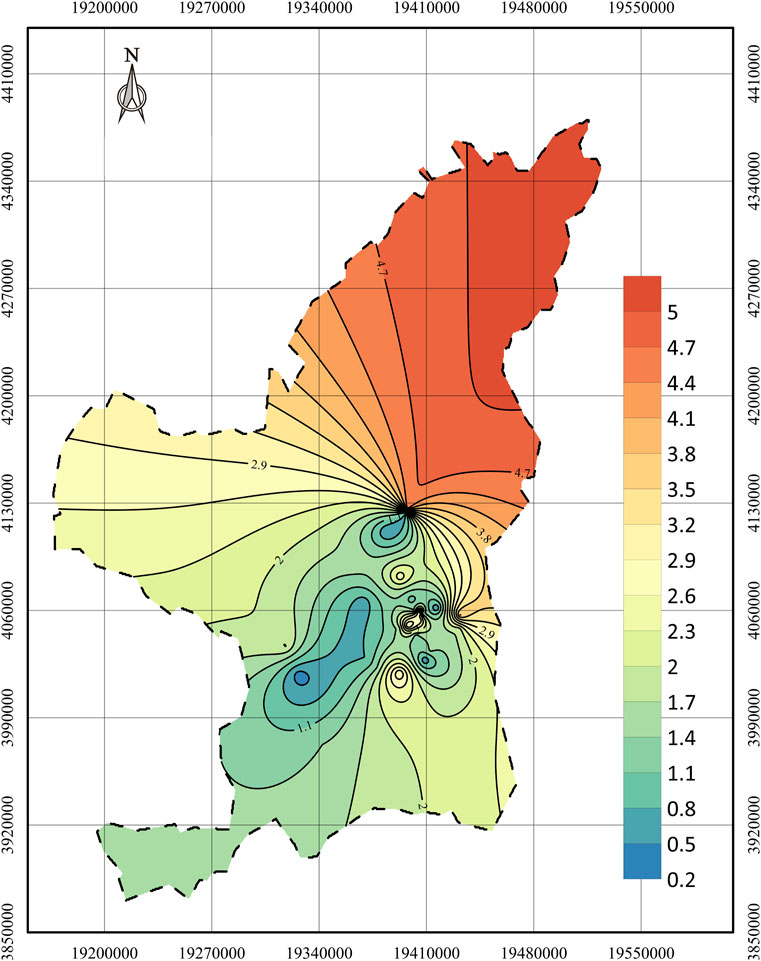
Figure 5. Isogram of organic carbon content in Upper Paleozoic shale source rocks in Yan’ an Gas field.
5.1.2 Content of chloroform extractable bitumen “A”
Due to the high maturity to over-maturity stage of the Upper Paleozoic coal-measure source rocks in the study area, most of the residual soluble organic matter and thermally degradable organic matter have escaped. Consequently, the content of chloroform bitumen “A” is generally low and cannot accurately indicate the organic matter abundance in this region; it serves merely as a reference for comprehensive evaluation.
The chloroform bitumen “A” content in the Upper Paleozoic source rocks of the study area is relatively low, ranging from 0.0002% to 0.0023%. Notably, the chloroform bitumen “A” content in coal samples is higher than that in mudstone samples, with values ranging from 0.0018% to 0.017%. Except for two mudstone samples from the Benxi Formation, the chloroform bitumen “A” content in other mudstone source rocks is significantly lower than in coal samples. The average content of chloroform bitumen “A” in Upper Paleozoic mudstones is 0.00117%, with values ranging from 0.0002% to 0.023%, showing a gradual increase from shallow to deep layers. Specifically, the chloroform bitumen “A” content in the Shihezi Formation mudstones ranges from 0.0005% to 0.0021%, with an average of 0.0009%; in the Shanxi Formation, it ranges from 0.0002% to 0.0037%, with an average of 0.0014%; in the Taiyuan Formation, it ranges from 0.0004% to 0.0046%, with an average of 0.0017%. The Benxi Formation has only two mudstone samples, with chloroform bitumen “A” content ranging from 0.0193% to 0.0230% (see Table 3).
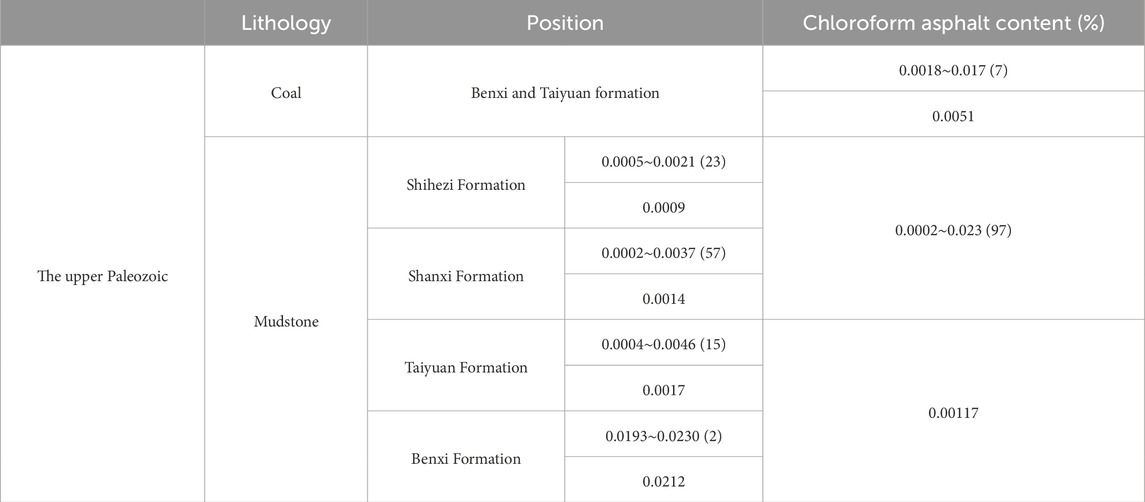
Table 3. Parameter table of chloroform asphalt “A” of Upper Paleozoic coal measure source rock in Yan’ an Gas field.
5.1.3 hydrocarbon generation potential characteristics
The minimum lower limit for the hydrocarbon generation potential of non-source rocks in coal-measure source rocks is set at 0.5 mg/g (Wang and Yin, 2019). Similar to chloroform bitumen, for source rocks with a maturity level higher than high maturity, the hydrocarbon generation potential serves only as a reference for comprehensive evaluation according to relevant standards.
In the study area, the hydrocarbon generation potential (S1 + S2) of the Upper Paleozoic coal-measure source rock samples is generally low, except for the coal samples. Specifically, the S1 + S2 values for coal samples range from 0.90 mg/g to 8.047 mg/g, with an average of 2.78 mg/g. In contrast, the S1 + S2 values for mudstone range from 0.01 mg/g to 4.22 mg/g, with an average of 0.291 mg/g.
For the Shihezi Formation mudstone, the S1 + S2 values range from 0.02 mg/g to 0.52 mg/g, with an average of 0.152 mg/g. The Shanxi Formation mudstone shows S1 + S2 values ranging from 0.01 mg/g to 1.49 mg/g, averaging 0.204 mg/g. The Taiyuan Formation mudstone has S1 + S2 values between 0.08 mg/g and 4.22 mg/g, with an average of 0.693 mg/g. Finally, the Benxi Formation mudstone exhibits S1 + S2 values ranging from 0.06 mg/g to 0.51 mg/g, averaging 0.212 mg/g (see Table 4).
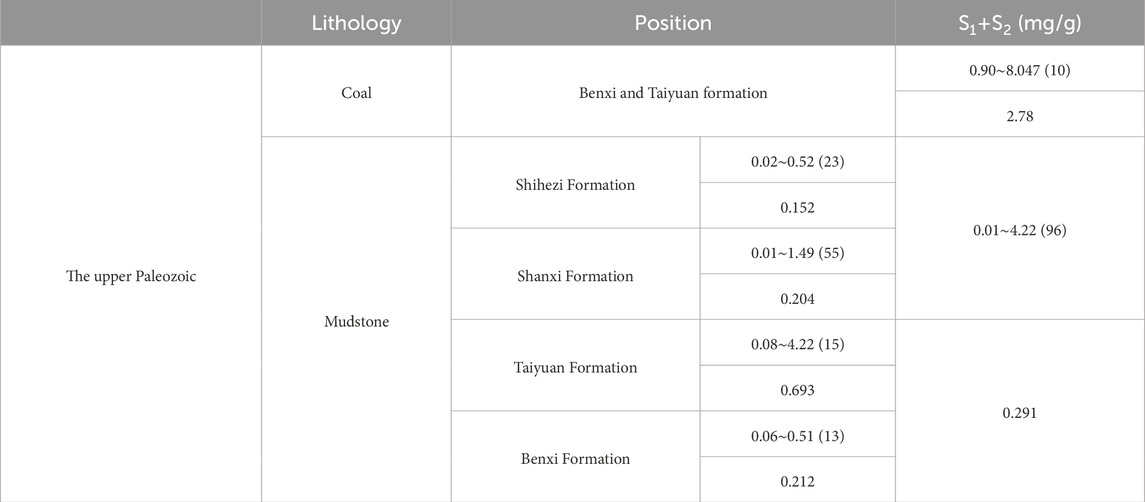
Table 4. Hydrocarbon generation potential parameters of Upper Paleozoic coal measure source rocks in Yan’ an gas field.
5.2 Organic matter type characteristics
In this study, kerogen maceral and organic element determination (H/C-O/C) methods were used to analyze and evaluate the organic matter types of source rocks (Wang and Yin, 2019).
5.2.1 Maceral characteristics of kerogen
A total of 213 samples of mudstone and coal were analyzed for the identification of kerogen, with the relative percentage distribution of its four types presented in Table 5. Among the samples, there are 109 instances of Type III kerogen, 62 instances of Type II2 kerogen, 47 instances of Type II1 kerogen, and 12 instances of Type I kerogen.
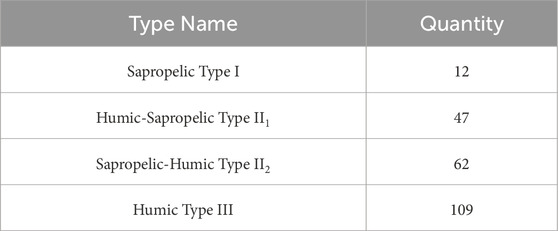
Table 5. Table of kerogen types and quantity of organic matter in source rocks in Yanchang gas area.
In the study area, the kerogen types extracted from coal samples are primarily Type III kerogen, with vitrinite content exceeding 80%. In the mudstone samples, Type III kerogen is predominant, with the main composition being vitrinite, while the contents of exinite and inertinite are relatively low. However, in the Upper Paleozoic mudstone source rocks, not only is there a significant presence of Type III kerogen, but there is also a certain proportion of Type II1 and II2 kerogen, while Type I kerogen is relatively scarce (Thul, 2012) (Figure 6 and Table 6).

Table 6. Maceral components of kerogen in Upper Paleozoic source rocks of Yan’ an Gas Field (average).
Based on the contour map of organic matter type indices for the Upper Paleozoic source rocks in the Yanan Gas Field (Figure 7), it is observed that the organic matter type index exhibits a pattern of higher values in the central area and lower values towards the edges. According to the classification standards for organic matter type indices, areas with indices less than 20 are predominantly composed of humic kerogen, while those with indices ranging from 20 to 40 mainly consist of humic-sapropelic kerogen. In regions with indices greater than 40, sapropelic-humic kerogen is the dominant type.
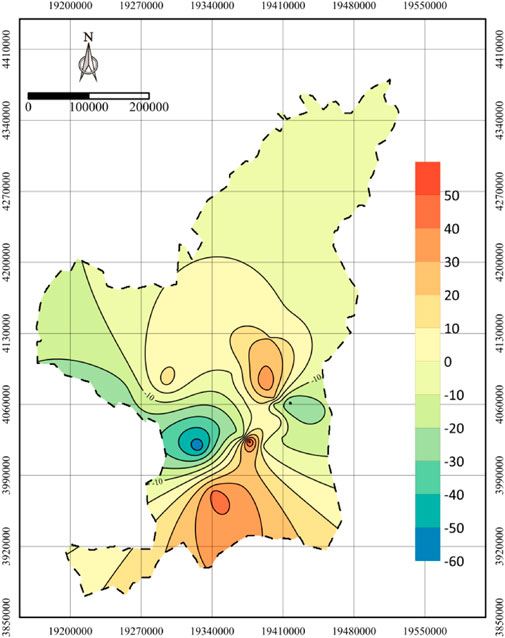
Figure 7. Contour map of organic matter type index of Upper Paleozoic source rocks in Yan’ an Gas field.
From the analysis of Figure 7, it can be concluded that the overall kerogen in the study area is primarily of humic type. In the central region of the study area, the kerogen is mainly composed of humic-sapropelic and sapropelic-humic types. Additionally, both the western and eastern edges of the study area feature the development of humic-type kerogen.
5.2.2 Composition characteristics of kerogen elements
By projecting the H/C atomic ratio and O/C atomic ratio onto the “Van Krevelen” diagram (see Figure 8), it can be observed that most of the sample points from the study area fall on both sides of the Type III kerogen region, while a small portion of samples is located within the Type II kerogen area. This indicates that the organic matter type of the Permian source rocks in the Yanan Gas Field generally leans towards gas generation. However, there are notable differences across various regions.
The analysis suggests that the kerogen types favoring gas generation can be attributed to two main factors: first, the samples have relatively high maturity levels; second, most of these samples originate from fluvial facies, which possess poorer organic matter quality, thus naturally categorizing them within the humic kerogen range.
The data presented in Figure 8 indicates that the O/C and H/C atomic ratios of most samples from the study area are located on both sides of the Type III and Type II kerogen regions, suggesting that the organic matter type of the Permian source rocks in the Yanan Gas Field generally leans towards gas generation. However, variations exist across different regions.
The analysis identifies two primary reasons for the kerogen types favoring gas generation: first, the samples exhibit relatively high maturity levels; second, these samples predominantly originate from fluvial facies deposits, which have poorer organic matter quality, thus classifying them within the humic kerogen range.
5.3 Maturity characteristics of organic matter
In this study, vitrinite reflectance and rock pyrolysis peak temperature were used to analyze and evaluate the maturity of organic matter in source rocks (Wang and Yin, 2019; Yu and Yin, 2023; Li et al., 2019c).
5.3.1 Vitrinite reflectance characteristics
In the Upper Paleozoic coal source rock samples from the Yanan gas field, the reflectance (Ro) values of 5 coal samples range from 1.95% to 3.28%, with an average value of 2.67%, indicating that they are in the over mature gas stage. The Ro values for 30 mudstone samples from the Shihezi Formation range from 1.48% to 2.25%, with an average value of 2.01%. The Ro values for 65 mudstone samples from the Shanxi Formation range from 1.66% to 2.78%, with an average value of 2.19%, also indicating the over mature gas stage. The Ro values for 5 mudstone samples from the Taiyuan Formation range from 1.88% to 2.82%, with an average value of 2.22%. The Ro values for 4 mudstone samples from the Benxi Formation range from 1.98% to 2.88%, with an average value of 2.31%. Overall, these samples exhibit characteristics indicative of the over mature gas stage (see Table 7). These data suggest that the coal source rocks in the Upper Paleozoic of the Yanan gas field are generally in the over mature gas stage, reflecting a high degree of thermal evolution of the organic matter in this area.

Table 7. Reflectance parameters of vitrinite source rocks of Upper Paleozoic coal measures in Yan’ an Gas field.
In the central Ordos Basin, the planar characteristics of the reflectance (Ro) of vitrinite in the Upper Paleozoic coal source rocks indicate that most areas in the study zone have Ro values greater than 2.0%, generally reaching the over mature gas stage (see Figure 9). The planar distribution of Ro values shows a certain regularity, with the lowest maturity of the source rocks in the central area of the study zone at 1.7%, gradually increasing towards the northwestern and southwestern edges, reaching a maximum of 3.3%. Overall, the organic matter maturity of the Upper Paleozoic coal source rocks in the Yanan gas field is relatively high, generally in the over mature gas stage, indicating that this area is well-developed for Upper Paleozoic source rocks.
5.3.2 Maximum pyrolysis peak temperature
According to the analysis results of the Tmax values of core samples from the Upper Paleozoic coal source rocks in the Yanan gas field, all five tested coal samples in the study area are in the over mature stage, with pyrolysis peak temperatures ranging from 561°C to 572°C, with an average value of 568°C. Among the 119 shale samples, the minimum Tmax value is 377°C, the maximum is 587°C, and the average is 531°C. Specifically, the Tmax values for the shale samples of the Shihezi Formation have a minimum of 419°C, a maximum of 564°C, and an average of 516°C; the Shanshi Formation shale samples have a minimum of 377°C, a maximum of 587°C, and an average of 529°C; the Taiyuan Formation shale samples have a minimum of 486°C, a maximum of 580°C, and an average of 552°C; the Benxi Formation shale samples have a minimum of 491°C, a maximum of 573°C, and an average of 538°C (Table 8).
When the maximum pyrolysis peak temperature exceeds 490°C, it indicates that the organic matter has entered the over mature stage. In the coal source rock samples from the Yanan gas field, 86% of the samples have maximum pyrolysis peak temperatures exceeding 490°C, indicating that the coal source rocks of the Shihezi Formation, Shanshi Formation, Taiyuan Formation, and Benxi Formation have overall entered the over mature stage (see Figure 10).
6 Discussion
The evaluation of hydrocarbon generation potential in the Upper Paleozoic source rocks of the Yanchang gas field highlights significant geological and economic implications. The Benxi and Taiyuan Formations exhibit considerable potential, primarily due to Type III kerogen and an overmature state, indicating dry gas generation. This aligns with the characteristics of thermally mature coal-derived gases in the Ordos Basin, including those in the Jingbian Gasfield (Ashraf et al., 2024a; Hu et al., 2024).
Advanced seismic inversion techniques, particularly constrained sparse spike inversion (CSSI), reveal promising facies such as braided fluvial channels and porous zones. These features, prevalent in formations like Shanxi and Taiyuan, are key indicators of zones with optimal reservoir quality for gas recovery. The analysis further shows the importance of identifying regions of lower acoustic impedance, which indicate higher porosity and better hydrocarbon recovery prospects (Lü et al., 2024; Liu et al., 2019).
The distribution of hydrocarbon source rocks in the Upper Paleozoic of the Yanan gas field exhibits distinct regional characteristics. In the central and southern regions, the organic matter maturity (Ro value) reaches 3.1 or higher, indicating that the organic matter in these areas has undergone a high degree of thermal evolution and possesses mature hydrocarbon potential. These high Ro value regions suggest that organic matter has been converted into oil and gas and may have entered the main generation phase for hydrocarbons. Furthermore, these areas are typically associated with higher hydrocarbon generation efficiency, making them key areas for focus and exploration. High maturity implies that the oil and gas yield and quality in these regions may be higher, providing significant economic value.
In contrast, the northern and northwestern regions exhibit lower organic matter maturity, with Ro values around 1.7 to 2.0, indicating that the thermal evolution degree of the organic matter in these areas is relatively low and has not yet reached the maturity required for efficient hydrocarbon generation. These regions may still be in the early stages of hydrocarbon generation, with lower potential for hydrocarbon production. Low Ro values suggest that the oil and gas resources in these areas are primarily in an immature or early maturity state, requiring a longer time or higher temperature conditions to transform into economically recoverable oil and gas resources.
The type index in the southern and central regions reaches 50 or higher, indicating that the organic matter in these areas is predominantly of Type II kerogen. Type II kerogen can generate a significant amount of liquid hydrocarbons (oil) during thermal evolution, indicating strong oil generation potential. High type index regions are often markers of high-quality hydrocarbon source rocks and should be prioritized for exploration and development, as they are expected to provide a large quantity of high-quality oil and gas resources. In comparison, the northern and western regions have a lower type index, approximately −60 to 0, suggesting that the organic matter types may be primarily Type III kerogen, which mainly generates gaseous hydrocarbons (natural gas). Although the oil generation potential is relatively poor, there remains some potential for gas generation, making these areas suitable for the development of natural gas resources.
The TOC (Total Organic Carbon) values in the northern and central regions reach 4.4 or higher, indicating that these areas have a rich organic matter content, which is a significant marker of high-quality hydrocarbon source rocks. High TOC values suggest that the sedimentary environment for organic matter in these areas is favorable, providing high hydrocarbon generation potential and indicating that these regions are accumulation zones for oil and gas resources, warranting further exploration and development. Conversely, the southern and southwestern regions have lower TOC content, around 0.2 to 2.0. While these areas have less organic matter and lower-quality hydrocarbon source rocks, there may still be locally concentrated high-quality hydrocarbon source rocks. Detailed geological exploration efforts will help identify these potential accumulation zones and assess their feasibility for economic development.
In summary, high-quality hydrocarbon source rocks in the Upper Paleozoic of the Yanan gas field are primarily concentrated in the central and southern regions, where the organic matter maturity is high (high Ro value), type index is high, and organic carbon content is rich (high TOC), indicating good hydrocarbon generation potential. These regions should be prioritized for exploration and development. Although the northern region has higher TOC content, its low Ro value and type index indicate a primary focus on gas generation, making it a potential area for natural gas resource development. Despite the lower TOC content in the southern and southwestern regions, detailed exploration is still necessary to determine the distribution of locally concentrated high-quality hydrocarbon source rocks.
7 Conclusion
(1) The Upper Paleozoic hydrocarbon source rocks in the Yanan gas field have generally good organic matter abundance. The mudstones and coals of the Shanxi, Taiyuan, and Benxi Formations largely reach an excellent level, demonstrating good hydrocarbon generation potential.
(2) The kerogen types in the Upper Paleozoic mudstone hydrocarbon source rocks include not only Type III but also a certain proportion of Type II1 and Type II2, while Type I kerogen is relatively scarce. Overall, the kerogen in the study area is primarily humic in type, with the central region dominated by humic-sapropelic and sapropelic-humic types. Both the western and eastern margins of the study area feature the development of humic kerogen, primarily generating gas.
(3) The Upper Paleozoic coal-measure hydrocarbon source rocks in the Yanchang gas field are generally in the overmature dry gas stage. The maturity of the source rocks is lowest in the central part (1.7%), increasing gradually towards the northwest and southwest margins, reaching a maximum value of 3.3%.
(4) High-quality hydrocarbon source rocks in the Upper Paleozoic of the Yanan gas field are primarily concentrated in the central and southern regions, where the organic matter maturity is high (high Ro value), type index is high, and organic carbon content is rich (high TOC), indicating good hydrocarbon generation potential.
Data availability statement
The original contributions presented in the study are included in the article/supplementary material, further inquiries can be directed to the corresponding author.
Author contributions
YW: Writing–original draft. ZW: Writing–review and editing. MC: Writing–original draft. KL: Writing–original draft, Writing–review and editing. WL: Writing–original draft.
Funding
The author(s) declare that no financial support was received for the research, authorship, and/or publication of this article.
Conflict of interest
Authors YW and ZW were employed by Gas Field Company, Shaanxi Yanchang Petroleum (Group) Co., Ltd.
The remaining authors declare that the research was conducted in the absence of any commercial or financial relationships that could be construed as a potential conflict of interest.
Generative AI statement
The author(s) declare that no Generative AI was used in the creation of this manuscript.
Publisher’s note
All claims expressed in this article are solely those of the authors and do not necessarily represent those of their affiliated organizations, or those of the publisher, the editors and the reviewers. Any product that may be evaluated in this article, or claim that may be made by its manufacturer, is not guaranteed or endorsed by the publisher.
References
Ashraf, U., Zhang, H., Anees, A., Ali, M., Mangi, H. N., and Zhang, X. (2024a). An ensemble-based strategy for robust predictive volcanic rock typing efficiency on a global scale: a novel workflow driven by big data analytics. Sci. Total Environ. 937, 173425. doi:10.1016/j.scitotenv.2024.173425
Ashraf, U., Zhang, H., Thanh, H. V., Anees, A., Ali, M., Duan, Z., et al. (2024b). A robust strategy of geophysical logging for predicting payable lithofacies to forecast sweet spots using digital intelligence paradigms in a heterogeneous gas field. Nat. Resour. Res. 33 (4), 1741–1762. doi:10.1007/s11053-024-10350-4
Bai, Y., Huang, L., and Zhao, J. (2020). Geochemical characteristics of chang 91 source rocks of upper triassic Yanchang Formation in zhidan-ansai area, Ordos Basin and its significance for tight oil exploration. Petroleum Sci. Technol. 38 (6), 524–534. doi:10.1080/10916466.2020.1772819
Chen, G., Wang, N., Yang, S., Li, X., Zhang, P., and Su, Y. (2022). Source rock potential of the upper triassic chang 7 member in the western Ordos Basin, China. J. Petroleum Geol. 45 (4), 395–415. doi:10.1111/jpg.12825
Chen, Y., Zhou, Y., Zhou, T., Zhao, H., Mu, H., and Zhang, C. (2023). Geochemical characteristics and evaluation criteria of overmature source rock of the laiyang Formation in well LK-1, riqingwei basin, eastern China. Energies 16 (8), 3482. doi:10.3390/en16083482
Cui, J., Ren, Z., Tao, H., Qi, K., Liu, H., Chen, K., et al. (2023). Thermal evolution and hydrocarbon generation history of the Weibei uplift in the Ordos Basin. Interpretation-A J. Subsurf. Charact. 11 (3), 489–502. doi:10.1190/int-2022-0073.1
Dai, Z., Wolfsberg, A., Lu, Z., and Reimus, P. (2007). Upscaling matrix diffusion coefficients for heterogeneous fractured rocks. Geophys. Res. Lett. 34 (7). doi:10.1029/2007gl029332
He, J., Zhang, X., Ma, L., Wu, H., and Ashraf, M. (2016). Geological characteristics of unconventional gas in coal measure of Upper Paleozoic coal measures in Ordos Basin, China. Earth Sci. Res. J. 20 (1), 1–5. doi:10.15446/esrj.v20n1.54140
Hu, M., Niu, Q., Yuan, W., Wang, W., Chang, J., Du, Z., et al. (2024). Evolution characteristic and mechanism of microstructure, hydraulic and mechanical behaviors of sandstone treated by acid-rock reaction: application of in-situ leaching of uranium deposits. J. Hydrology 643, 131948. doi:10.1016/j.jhydrol.2024.131948
Huo, Z., Pang, X., Chen, J., Zhang, J., Song, M., Guo, K., et al. (2019). Carbonate source rock with low total organic carbon content and high maturity as effective source rock in China: a review. J. Asian Earth Sci. 176, 8–26. doi:10.1016/j.jseaes.2019.01.038
Jiang, F., Jia, C., Pang, X., Jiang, L., Zhang, C., Ma, X., et al. (2023). Upper Paleozoic total petroleum system and geological model of natural gas enrichment in Ordos Basin, NW China. Petroleum Explor. Dev. 50 (2), 281–292. doi:10.1016/s1876-3804(23)60387-8
Kai, C., Dong, L., and Peng, X. (2016). Study on distribution of source rocks in Ordos Basin. J. Balkan Tribol. Assoc. 22 (1A), 993–1000.
Karakurt, I., and Aydin, G. (2023). Development of regression models to forecast the CO2 emissions from fossil fuels in the BRICS and MINT countries. Energy 263, 125650. doi:10.1016/j.energy.2022.125650
Li, A., Bai, Y., and Yin, S. (2018). Organic geochemical characteristics of the Upper Triassic source rocks in the eastern Ordos Basin, China. Petroleum Sci. Technol. 36 (22), 1843–1849. doi:10.1080/10916466.2018.1501390
Li, G., Liu, C., Chen, Z., Awan, R. S., Wang, F., Wang, G., et al. (2019c). Investigation on the thermal maturity, organic matter sources and depositional environment of lacustrine source rocks in the Dongying Formation of the Bozhong Sag, Bohai Bay Basin, China. Bohai Bay 59 (5), 1539–1567. doi:10.1002/gj.4956
Li, H. (2015). Study on the upper paleozoic source rocks in the central Ordos Basin [D]. China: Northwest University.
Li, Y., Wang, Z., Wu, P., Gao, X., Yu, Z., Yu, Y., et al. (2019b). Organic geochemistry of Upper Paleozoic source rocks in the eastern margin of the Ordos Basin, China: input and hydrocarbon generation potential. J. Petroleum Sci. Eng. 181, 106202. doi:10.1016/j.petrol.2019.106202
Li, Y., Yang, J., Pan, Z., Meng, S., Wang, K., and Niu, X. (2019a). Unconventional natural gas accumulations in stacked deposits: a discussion of Upper Paleozoic coal-bearing strata in the east margin of the Ordos Basin, China. Acta Geol. Sinica-English Ed. 93 (1), 111–129. doi:10.1111/1755-6724.13767
Li, Z., Li, H., Li, W., Sun, J., and Li, K. (2023). Organic geochemical features of the upper paleozoic coal-bearing deposits in Ordos Basin, north-Central China. Energies 16 (5), 2302. doi:10.3390/en16052302
Liu, D., Li, J., Liu, J., and Zhang, L. (2020). Modeling hydrocarbon accumulation based on gas origin and source rock distribution in Paleozoic strata of the Ordos Basin, China. Int. J. Coal Geol. 225, 103486. doi:10.1016/j.coal.2020.103486
Liu, J., Liu, K., and Liu, C. (2019). Quantitative evaluation of gas generation from the Upper Paleozoic coal, mudstone and limestone source rocks in the Ordos Basin, China. J. Asian Earth Sci., 178:224–241. doi:10.1016/j.jseaes.2018.04.001
Lü, Q., Liu, S., Mao, W., Yu, Y., and Long, X. (2024). A numerical simulation-based ANN method to determine the shear strength parameters of rock minerals in nanoscale. Comput. Geotechnics 169, 106175. doi:10.1016/j.compgeo.2024.106175
Lu, Z., Chen, S., Li, Y., He, Q., Zhang, J., and Zhang, H. (2018). Geochemical characteristics and origins of the crude oil of Yanchang formation chang 2 in ansai area, erdos basin, China. Petroleum Sci. Technol. 36 (17), 1419–1425. doi:10.1080/10916466.2018.1482327
Ma, L., Ma, L., Liu, T., Ha, J., and Yu, Y. (2020). Source rock characteristics and hydrocarbon generation environment analysis of Chang 7 Member in southeast area of Ordos Basin, China. Fresenius Environ. Bull. 29 (12A), 11301–11310.
Ozdemir, A. C. (2023). Decomposition and decoupling analysis of carbon dioxide emissions in electricity generation by primary fossil fuels in Turkey. Energy 273, 127264. doi:10.1016/j.energy.2023.127264
Qin, Y., Moore, T. A., Shen, J., Yang, Z., Shen, Y., and Wang, G. (2018). Resources and geology of coalbed methane in China: a review. Int. Geol. Rev. 60 (5-6), 777–812. doi:10.1080/00206814.2017.1408034
Ratnayake, A. S. (2024). An overview of organic geochemical indices to evaluate conventional petroleum source rocks: a summary of examples from the Indian Subcontinent. Petroleum Sci. Technol. 42 (7), 749–767. doi:10.1080/10916466.2022.2134893
Runsheng, H., Yan, Z., Wenlong, Q., Tianzhu, D., Mingzhi, W., and Feng, W. (2023). Geology and geochemistry of Zn-Pb(-Ge-Ag) deposits in the Sichuan-Yunnan-Guizhou Triangle area, China: a review and a new type. Geochem. Rev. 11. doi:10.3389/feart.2023.1136397
Thul, D. J. (2012). Niobrara source rock maturity in the Denver Basin: a study of differential heating and tectonics on petroleum prospectivity using programmed pyrolysis. (in Chinese).
Tissot, B. P., and Welte, D. H. (1984). Petroleum Formation and occurrence: a new approach to oil and gas exploration, 1984. Springer-Verlag Berlin Heidelberg.
Umar, A., Zhang, Hu., Aqsa, A., Ali, M., Zhang, X., Shakeel Abbasi, S., et al. (2020). Controls on reservoir heterogeneity of a shallow-marine reservoir in sawan gas field, SE Pakistan: implications for reservoir quality prediction using acoustic impedance inversion. Water 12 (11), 2972. doi:10.3390/w12112972
Wan, Y., Li, H., Li, Y., Song, Z., and Qi, Z. (2017). The field stress between late jurassic and early cretaceous in the eastern Ordos Basin. Earth Sci. 42 (4), 549–558.
Wang, F., and Yin, S. (2019). Hydrocarbon generation potential of the C-P continental source rocks in the Qinshui Basin. Petroleum Sci. Technol. 37 (2), 208–214. doi:10.1080/10916466.2018.1533865
Wu, Y., and Zhang, J. (2018). Geochemical characteristics and identification criteria of effective source rock in Mesozoic Yanchang Formation, southern margin of Ordos Basin. Int. J. Oil Gas Coal Technol. 19 (4), 1–395. doi:10.1504/ijogct.2018.10014997
Xu, Z., Sun, W., Yang, J., Shen, B., Xu, X., Wang, X., et al. (2023). Automatic pretreatment methods for determination of total organic carbon in sedimentary rocks. Rock Mineral Analysis 42 (6), 1230–1239.
Yang, R., Zhao, X., Li, H., Zhao, C., Pu, X., Liu, H., et al. (2020). Evolution characteristics of the Upper Paleozoic source kitchen and its controlling effects on hydrocarbon accumulation in the Paleozoic petroleum system in Huanghua Depression, Bohai Bay Basin, China. J. Petroleum Sci. Eng. 19, 107415. doi:10.1016/j.petrol.2020.107415
Yu, Z., and Yin, S. (2023). Experimental study on geochemical characteristics of Paleogene source rocks. Chem. Technol. Fuels Oils 59 (3), 588–598. doi:10.1007/s10553-023-01559-9
Keywords: Ordos basin, coal-bearing source rocks, upper Paleozoic, source rock evaluation, Yan’ an gas area
Citation: Wan Y, Wang Z, Cui M, Liu K and Li W (2025) Evaluation of Upper Paleozoic source rocks in the southeastern margin of the Ordos Basin. Front. Earth Sci. 12:1508427. doi: 10.3389/feart.2024.1508427
Received: 09 October 2024; Accepted: 02 December 2024;
Published: 15 January 2025.
Edited by:
Ziming Yang, Oakland University, United StatesCopyright © 2025 Wan, Wang, Cui, Liu and Li. This is an open-access article distributed under the terms of the Creative Commons Attribution License (CC BY). The use, distribution or reproduction in other forums is permitted, provided the original author(s) and the copyright owner(s) are credited and that the original publication in this journal is cited, in accordance with accepted academic practice. No use, distribution or reproduction is permitted which does not comply with these terms.
*Correspondence: Zhenchuan Wang, MTI0NTkzMDUyQHFxLmNvbQ==
 Yongping Wan1
Yongping Wan1 Zhenchuan Wang
Zhenchuan Wang Kouqi Liu
Kouqi Liu
